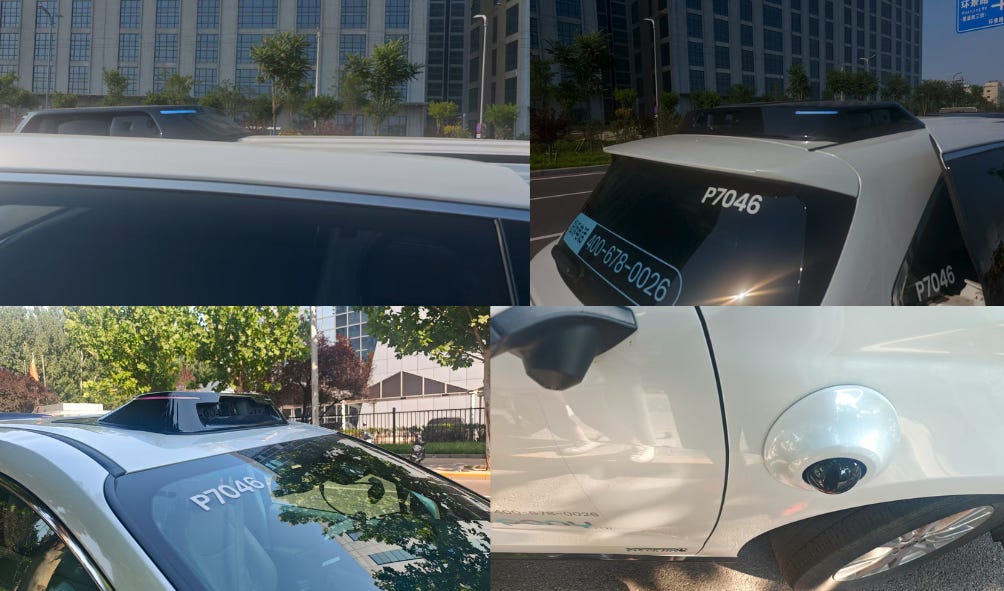The Autonomous Divide: Comparing China's L4 Robotaxi and the Tesla Doctrine | Part 1
world model #10
You’ve probably watched enough videos of Tesla robotaxis and Waymo’s autonomous vehicles, making their rounds on public roads. Robotaxis are becoming a tangible part of our urban landscape, both in the United States and China.
In this article, we’ll dive deep into the comparison between Tesla’s robotaxi operation and Chin’a Pony.ai robotaxi, focusing on the product aspects, autonomous driving capabilities, UX design, pricing models, and privacy considerations.
The Brains of the Machine - Deep Dive into Autonomous Capability
The technological architecture of a robotaxi is its very soul, dictating its capabilities. limitations, and path to scale. The chasm between Tesla’s strategy and that of its Chinese counterparts is most evident here, revealing how distinct business imperatives have forged fundamentally different engineering philosophies.
Tesla’s Vision-Only Gambit: The Power of the Fleet
Tesla’s approach to autonomy is a direct extension of its identity as a mass-market electric vehicle manufacturer. The core philosophy, articulated repeated by CEO Elon Musk, is that fully autonomy is primarily a software problem that can be solved with advanced AI. This belief underpins the company’s controversial decision to eschew LiDAR, a sensor Musk has famously dismissed as “stupid, expensive and unnecessary, ” and pursue a “vision-only” system that mimics human perception.
The hardware and software stack is built around this principle. The system relies on a suite of cameras distributed around the vehicle, feeding a torrent of visual data into a custom-designed self-driving computer chip. The current hardware iterations, HW3 and HW4, are engineered for massively parallel processing, allowing the vehicle’s end-to-end neural networks to handle perception, prediction, and planning in real-time.
The true enabler of this strategy - and Tesla’s most significant competitive advantage - is the immense dataset harvested from its global fleet. With of 6 million consumer vehicles on the road, Tesla has access to billions of miles of real-world driving data, creating a powerful data flywheel that continuously trains and refines its neural networks. No other company can match this scale of data collection. The consumer-facing product, “Full Self-Driving(Supervised), ” already handles complex tasks like semi-autonomous navigation, responding to traffic lights and stop signs, and assisted lane changes. The software builds deployed in the Austin Robotaxi pilot have demonstrated further advancements, including the ability to identify and pull over for emergency vehicles and execute complex maneuvers like U-turns with increasing confidence.
China’s L4 Playbook: The Sensor-Fusion Consensus
In stark contrast to Tesla’s singular vision, China’s leading L4 robotaxi companies - Baidu, Pony.ai, and WeRide - operate on a deeply ingrained principle of robust hardware redundancy. Their approach is rooted in traditional, safety-case-drvien systems engineering, which posits that true L4 autonomy, capable of operating without human oversight, requires a multi-modal sensor suite. This sensor-fusion strategy is designed so that the inherent weakness of one sensor type(e.g., cameras in low light or fog) are compensated for by the strengths of others (e.g., LiDAR and radar).
Baidu’s Apollo Go, the market leader in China, exemplifies this approach. Its vehicles are equipped with a comprehensive array of cameras, radar, and LiDAR, which work in concert with a sophisticated software system and high-definition(HD) maps to navigate complex urban environments. Having accumulated over 130 million autonomous kilometers, the Apollo GO service has established a significant track record of operational experience across numerous Chinese cities.
Pony.ai has built its entire system around multi-sensor fusion and redundancy. The company’s technical documentations explicitly details its adherence to the ISO 26262 functional safety standard, with a system designed to handle both single-point and dual-point failures. Its sixth-generation robotaxi system, for instance, features an extensive sensor array, including four roof-mounted solid-state LiDARs, three blind-spot detection LiDARs, three long-range millimeter-waive radars, and eleven cameras, ensuring comprehensive environmental perception.
sensor layout for Pony.ai robotaxi
(For more information, check the previous post)
WeRide has developed a universal autonomous driving platform, “WeRide One” that is both versatile and scalable. Its robotaxis are equipped with over 20 high-performance sensors and a high-performance computing platform delivering over 1,300 TOPS(Trillion Operations Per Second) of AI computing power. The company employs a sophisticated hybrid architecture that combines a deterministic, rule-based overlay with a more flexible end-to-end AI model, allowing it to leverage the benefits of both approaches. Furthermore, WeRide has developed solutions that can operate with either high-precision maps or in a “map-less” mode, enhancing its operational flexibility.
table
Analysis: Strategy Dictates Technology
The profound technological divergence between Tesla and the Chinese L4 operators is not arbitrary; it is a direct and logical consequence of their distinct business models and market positions. Tesla began as a consumer electronics company that happens to make cars. Its primary objective is to sell vehicles to individuals, and a low-cost, software-upgradable autonomous system like FSD represents a high-margin product that can be sold to its entire installed base. This business model almost necessitates a vision-only approach. Adding expensive LiDAR units to every consumer car would dramatically increase the base cost, making the vehicles less competitive and complicating the promise of delivering full autonomy via a simple over-the-air update to millions of existing cars.
Conversely, Chinese L4 players like Baidu, Pony.ai, and WeRide were founded largely as pure-play autonomous driving technology companies. Their primary business model is not selling cars to consumers, but rather operating a transportation-as-a-service (TaaS) network or licensing their full-stack solution to partners. For a TaaS operator, the high upfront cost of LiDAR and a complex sensor suite on a dedicated fleet is a justifiable capital expenditure. The goal is not mass-market affordability for an individual owner, but supreme operational robustness and safety within a defined service area to ensure the viability of the ride-hailing business itself.
This fundamental difference in strategy creates two entirely different scaling challenges. Tesla's challenge is predominantly algorithmic. Its success hinges on whether its AI, fueled by an unparalleled volume of data, can solve the "long tail" of edge cases that LiDAR-based systems are designed to handle through hardware redundancy. This is particularly critical in adverse weather conditions like heavy rain or fog, where camera performance is known to degrade significantly.5 If Tesla succeeds, it will possess an almost insurmountable cost advantage. If it fails, it risks hitting a hard performance ceiling that its hardware cannot overcome.
China's challenge, on the other hand, is primarily economic and operational. The key question is whether its operators can aggressively drive down the cost of their complex hardware stacks and efficiently manage the logistics of deploying and maintaining thousands of specialized vehicles across dozens of cities to achieve profitability. This is precisely why Baidu's sub-$30,000 RT6 and Pony.ai's Gen-7 system with its 70% cost reduction are such critical milestones. Their path to scale is more technologically predictable but vastly more capital-intensive, requiring sustained investment to navigate the long road to breaking even.
When Things Go Wrong - Emergency Takeover and Safety Protocols
A Level 4 autonomous system is defined by its ability to handle all driving tasks, including emergency fallbacks, without requiring human intervention within its operational domain. The methods employed by Tesla and its Chinese rivals to achieve this critical safety layer reveal differing philosophies on the role and placement of human oversight.
Tesla's Human-in-the-Loop Model: The On-Site Guardian
For its initial public-facing service in Austin, Tesla has adopted a cautious, human-in-the-loop safety model. Every robotaxi ride includes a trained Tesla employee, referred to as a “Safety Monitor,” seated in the front passenger seat. This is a crucial distinction from a traditional "safety driver," as the monitor has no access to a steering wheel or pedals, which have been removed or are non-functional in some test vehicles. Their role is purely to observe and intervene in an emergency.
The monitor's intervention tools are digital and physical. The main touchscreen provides a prominent "Stop In Lane" software button, allowing for an immediate but controlled stop. For more critical situations, a physical button—reportedly a reprogrammed door release button—acts as a hard emergency brake or kill switch. In nearly all videos from the Austin launch, monitors are seen with their finger or thumb constantly hovering over this physical button, a clear indication of its importance as the primary safety mechanism. The first publicly documented intervention occurred when a monitor used one of these systems to halt the vehicle during a complex, low-speed interaction with a reversing UPS truck, preventing a potential collision.
In addition to the in-car monitor, passengers have a direct line to remote human support. A “Call Support” button on the rear passenger screen initiates an almost instantaneous video call with an agent at Tesla's Robotaxi Operations Center. These remote agents can provide assistance and, according to Tesla's documentation, may be able to issue "directive commands" to the vehicle, suggesting a tele-assistance capability.9 However, for the initial launch, the primary safety layer remains the physical presence inside the vehicle.
China's Remote-First Safety Net: The Command Center
Chinese L4 operators have architected their safety systems around a "remote-first" philosophy, leveraging the country's advanced 5G infrastructure. This model replaces the in-car human with a team of remote operators in a centralized command center. When an autonomous vehicle encounters a situation it cannot resolve—such as an unusual construction zone or a complex interaction with traffic police—it can "call for help". A trained remote human operator can then either provide high-level guidance (e.g., confirming it is safe to proceed) or take direct control of the vehicle's steering, braking, and acceleration to navigate the tricky scenario before handing control back to the autonomous system.
Baidu has been a vocal proponent of this model, stating that its remote operators, who undergo over 1,000 hours of cloud-based driving training, are the key to enabling fully driverless operations without an in-car safety driver. The company's safety personnel are explicitly divided into two groups: in-vehicle testers for developing and validating new software, and remote monitors and operators for the commercially deployed fleet. Similarly, both Pony.ai and WeRide have developed and integrated autonomous remote assistance platforms as a core component of their technology stacks. WeRide's Robovan, for example, is managed via a cloud-based control platform that allows for remote fleet monitoring and intervention.
Crucially, this remote safety net is the final layer of a deeply redundant system. The vehicles are designed to handle most failures on their own first. Pony.ai's architecture, for example, includes over 20 distinct types of redundancies across software, hardware, and the vehicle platform itself. In the event of a system failure, the vehicle is designed to automatically enter a "Minimal Risk Condition" (MRC), such as safely pulling over to the side of the road, without any human input. WeRide similarly highlights its "8 major redundancy systems" as a foundational element of its safety case.
Analysis: Scalability vs. Perception
The choice between an in-car monitor and a remote command center is driven by a combination of technological maturity and public relations strategy. Tesla's FSD, while improving rapidly, is still officially classified as a Level 2 driver-assist system for its consumer fleet. The Austin Robotaxi service represents its first foray into true driverless operation with the public. In this context, the presence of an in-car safety monitor is a pragmatic and likely legally necessary step. It acts as a bridge technology, allowing the company to gather data and experience in a controlled manner while mitigating risk. In contrast, Chinese operators have been conducting L4 testing for years and have secured government approval to run fully driverless services in designated zones. Their systems were designed from the outset with the remote operation model as the intended, scalable end-state, not as a temporary measure.
This leads to a fascinating paradox in scalability. Tesla's in-car monitor model is fundamentally unscalable. A network of one million robotaxis cannot function if each requires a paid employee sitting inside. Therefore, Tesla's entire business case hinges on its ability to remove this human safety net very quickly, which places immense pressure on its AI development to achieve a near-perfect safety record at an exponential rate. The Chinese remote operator model is far more scalable, but it is not infinitely so. While one remote operator can likely monitor a small fleet of vehicles simultaneously, they cannot manage hundreds. This implies a future where even a large, mature robotaxi network will require a significant human workforce in command centers, impacting long-term operational costs. The model shifts the labor equation from a one-to-one ratio (one driver per car) to a one-to-many ratio (one operator for N cars), but it does not eliminate human labor costs entirely. The ultimate economic winner will be the company that can achieve the highest value of N, or, like Tesla hopes, eliminate the human operator from the equation altogether.
The Digital Proving Grounds - Routes and Operational Environments (ODD)
The Operational Design Domain (ODD) defines the specific conditions under which an autonomous vehicle is designed to operate safely. A comparison of the ODDs for Tesla and its Chinese counterparts reveals less about their raw technological capabilities and more about the starkly different regulatory landscapes and national strategies that govern their deployment.
Tesla's Beachhead in Austin: A Controlled Experiment
Tesla's robotaxi service began as a highly controlled and limited pilot. The initial launch in Austin, Texas, involved a fleet of just 10 modified Model Y vehicles operating within a strictly defined geofence in the southern part of the city.6 The ODD's parameters were carefully selected to manage complexity. The service operates during specific hours, from 6:00 AM to midnight, and is confined to "major corridors and high-demand zones" with what the company describes as "manageable road types and traffic densities".6 While Tesla has since expanded the service area, the operation remains a single-city pilot program, a sandbox for testing and validation.
A significant, though less explicitly defined, aspect of Tesla's ODD is weather. The vision-only system's reliance on cameras makes its performance in adverse conditions a critical question. While early riders have shared videos of the service operating in light rain, its capability and safety in heavy rain, dense fog, or snow—conditions where LiDAR and radar offer distinct advantages—remain a major unknown and a likely constraint on its current ODD.5
China's Nationwide Laboratory: Aggressive Expansion
The scale and complexity of China's robotaxi ODDs are an order of magnitude greater than Tesla's Austin pilot. L4 services are commercially operational in over 15 Chinese cities, including the sprawling Tier-1 megacities of Beijing, Shanghai, Guangzhou, and Shenzhen. Baidu's Apollo Go, the market leader, has plans to expand its service to 65 cities by 2025 and 100 cities by 2030.
These are not small, carefully manicured test zones. Baidu's operational area in Wuhan, a city of over 11 million people, now covers more than 3,000 square kilometers. WeRide has received authorization to operate in Beijing's core urban area, a service zone of over 600 square kilometers that includes one of Asia's busiest transport hubs, the Beijing South Railway Station, which sees over 150,000 passengers daily. Pony.ai offers fare-charging services to and from the massive Beijing Daxing International Airport. These ODDs encompass an enormous variety of challenging conditions, including dense, chaotic urban traffic, multi-lane highways, tunnels, and complex, irregular intersections.43
This aggressive, wide-scale deployment is made possible by a key factor: strong, centralized government support. The Chinese government has designated autonomous vehicles as a national strategic priority under its "Made in China 2025" industrial policy. This has translated into a regulatory framework that actively promotes and facilitates large-scale AV testing and commercialization in designated pilot zones across the country, creating a nationwide laboratory for the technology.
Analysis: Regulation as a Competitive Advantage
The vast difference in ODD scale is less a reflection of a massive technology gap and more a product of divergent regulatory philosophies. The United States operates under a more fragmented, cautious, and state-led regulatory environment. Tesla's limited Austin ODD is a direct result of needing to navigate this landscape; the company must prove its system's safety in a small, controlled sandbox before regulators will permit wider expansion.
In contrast, China's top-down, centralized approach treats its complex urban environments not as a liability to be avoided, but as a competitive advantage to be exploited. The government views its cities as ideal "testing grounds" that can accelerate AI development by exposing autonomous systems to a greater volume and variety of challenging scenarios. This state-backed push allows Chinese companies to operate in ODDs that are far larger and more complex than what is currently conceivable for Tesla in the U.S.
This creates a powerful "home-field advantage" for Chinese operators that could evolve into a significant competitive moat. The enormous and diverse dataset collected from operating across dozens of unique Chinese cities provides local players with an unparalleled understanding of the driving culture and infrastructure challenges specific to what is projected to become the world's largest market for autonomous vehicles. This deep operational experience, combined with the necessity of forming local partnerships and navigating China's strict data security laws, erects substantial barriers to entry for foreign competitors. Tesla's recent need to partner with Baidu to gain access to local mapping data and pass a government data security audit before launching its FSD features is a clear demonstration of this reality, highlighting how regulatory and data governance frameworks can shape the competitive landscape as much as pure technology.
(to be continued )






Love this breakdown — can China’s open loop win long term?